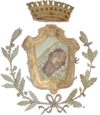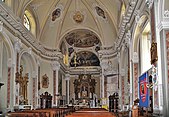Sappada
| Sappada | ||
|---|---|---|

|
|
|
| Country | Italy | |
| region | Friuli Venezia Giulia | |
| Local name | Plodn | |
| Coordinates | 46 ° 34 ' N , 12 ° 41' E | |
| height | 1250 m slm | |
| surface | 62.73 km² | |
| Residents | 1,315 (Dec. 31, 2019) | |
| Population density | 21 inhabitants / km² | |
| Factions | Cima Sappada, Cretta, Puiche, Ecche, Soravia, Kratten, Fontana, Cottern, Mühlbach, Bach, Pill, Palù, Granvilla, Lerpa | |
| Post Code | 33012 | |
| prefix | 0435 | |
| ISTAT number | 030189 | |
| Popular name | Sappadini / Plodnar | |
| Patron saint | St. Margaret | |
| Website | Sappada municipality | |
Sappada / Plodn ( German Bladen or Pladen, Plodarisch / sappadino: Plodn ) is a municipality in the northern Italian region of Friuli-Venezia Giulia . The place forms a German language island and has 1315 inhabitants (as of December 31, 2019).
geography
Sappada is located in the south of the Carnic Alps at an altitude of 1,200 m south of Monte Peralba ( Hochweißstein; Plodnerisch: Jochkouvl ). The municipality covers 62 km². Sappada is a village that consists of a chain of hamlets about five kilometers long, almost all of which have their own chapel and fountain.
The name Plodn can be derived from the German name of the river Piave that flows through the place.
history
In the Middle Ages, the area with the county of Cadore belonged to the Freising monastery of San Candido ( South Tyrol ). At that time, soon after AD 1000, the area was populated by German speakers from the nearby Puster Valley , especially from Villgraten . At the end of the 11th century, the Patriarch of Aquileja was able to enforce sovereignty over the Hochstift Freising . Bladen was first mentioned in a document around 1269. Originally founded as a mining settlement (iron extraction on Monte Ferro , smelting in the neighboring town of Forni Avoltri ), Bladen developed from the above-mentioned individual hamlets into a farming community. With the conquest of the patriarchy in 1420, Bladen also came under the rule of the Republic of Venice . With the Treaty of Campo Formio in 1786 it came to Austria, was separated from the Province of Friuli in 1852 and incorporated into the Province of Belluno . Although Bladen is not attributed to the Cadore , it joined the Magnifica Comunità del Cadore and finally came to Italy with Veneto in 1866. According to the law of December 5, 2017, no.182, the municipality of Pladen was re-incorporated into the Province of Udine in the Friuli-Venezia Giulia region.
Culture and sights
Language and customs
Sappada or Bladen is one of several German- speaking islands in Italy. The southern Bavarian dialect is still used today by the majority of the inhabitants of Pladen as an everyday language and shows their Hochpustertal origin, so that it differs significantly from the other language islands (see below). In 1972 Maria Hornung published a Pladner dictionary.
To consolidate the special traditions, Sappada maintains close contacts to the other German language islands in the provinces of Trento ( Lusern and Fersental ), Verona ( thirteen municipalities ), Vicenza ( seven municipalities ), Udine ( Tischlwang and Zahre ) and the Walser settlements in the Aosta and regions Piedmont .
Today Sappada is a much visited tourist destination in summer and winter. This has led to the immigration of Italian workers. In the younger generation, therefore, the "Plodnerische" was temporarily in decline. Recently, however, the dialect has been particularly encouraged by the church and also by various cultural associations. The Friuli-Venezia Giulia region and the province of Udine also promote the old tradition - in some cases with support from the EU -, albeit to a limited extent.
The annual traditional Carnival with the central figure “The rollate Lotter” (usually referred to as “Rollat” for short), the three Sundays (Beggar Sunday, Farmers Sunday and Gentlemen's Sunday) and the folk dance group “Holzhockar” are particularly interesting. The construction of the houses, which testifies to their East Tyrolean origin, also differs significantly from the Italian surrounding area.
Buildings
- Parish Church of St. Margareta . The baroque church was built in 1779 according to plans by Tommaso von Lienz. The frescoes inside are from 1906 by Francesco Barazzuti. They show the Assumption of Mary in the arched vault of the nave, and in the dome of the choir the recording of St. Margaret in the sky, on the left wall of the choir the death of St. Joseph's , on the right choir wall the martyrdom of St. Margareta. The picture of the high altar was painted by Johann Renzler in 1802.
- Church of St. Oswald in Cima Sappada, built in 1732 on the site of a more modest previous building. The ceiling fresco in the choir shows Mary, accompanied by putti , floating in the sky .
The baroque altar is a viersäuliger aedicula -Altar with a painting of the Maria St. revering. Oswald. There is an Eye of Providence in the essay . The painting on the left side altar shows Saints Joseph and Anthony . The right side altar is in a chapel. In the shrine stands a Maria Immaculata trampling the snake.
nature
- Sources of the Piave, accessible from Cima Sappada
politics
In March 2008, the municipality held a referendum on whether Sappada should be separated from the Veneto region ( Belluno province ) and incorporated into the Friuli-Venezia Giulia Autonomous Region ( Udine province ). Of the almost 1200 eligible voters, 75% voted, of which 95% were in favor of changing provinces. Both Friuli Venezia Giulia (2010) and Veneto (2012) gave the green light for the change. The corresponding draft law was presented to the Roman Parliament in 2013. Clarifying financial issues played an important role in the meantime. In November 2017, the Chamber of Deputies in Rome finally approved the incorporation into the Autonomous Region of Friuli Venezia Giulia (Province of Udine). According to the law of December 5, 2017 n.182, the municipality was incorporated into the Friuli Venezia Giulia region on December 16, 2017.
literature
- Aristide Baragiola : La casa villereccia delle colonie tedesche del gruppo carnico. Sappada, Sauris e Timau con raffronti delle zone contermini italiana et austriaca: Carnia, Cadore, Zoldano, Agordino, Carintia e Tirolo. Peregrinazione folcloriche. Tipografia Tettamanti, Chiasso 1915.
- Marcella Benedetti, Cristina Kratter: Plodar berterpuich. Associazione Plodar, Comune di Sappada Plodn 2010 (in Plodar, German and Italian).
- G. Fontana: Addio Vecchia Sappada. Feltre 1966 (in Italian).
- Maria Hornung : Dictionary of the German island vernacular from Pladen / Sappada in Carnia (Italy). Presented at the meeting on March 5, 1971. With utilization of the collections of Pietro Sartor Schlossar and illustrations by Franz Kratochwil . Böhlau, Vienna 1972.
- Günther Grewendorf, Cecilia Pelotto: From OV to VO: a comparison between Cimbrian and Plodarian.
- Maria Hornung: Pladner dictionary. Glossario Sappadino. Italian adaptation by Anna Gasser. Edition Praesens, Vienna 1995 (contributions to language island research 12).
- Ans, kans, hundred thousand. Berter saint et schtane. Frasario del “sappadino” by Cristina Kratter and Marcella Benedetti, Pieve di Cadore, Tipografia Tiziano, December 2006, ill (in Italian and Plodaric).
- Dictionary of Bavarian dialects in Austria .
Web links
- Sappada Municipality (Italian)
- Associazione "Plodar": Plodn cultural association (Italian)
- Language island association: Plodn / Sappada
- Website Sappada (German)
- Comelico Sappada Tourist Office (Italian)
Individual evidence
- ↑ Statistiche demografiche ISTAT. Monthly population statistics of the Istituto Nazionale di Statistica , as of December 31 of 2019.
- ↑ Sprachinselverein: "The spelling Bladen is erroneous, both etymologically and according to the pronunciation."
- ↑ Dictionnaire Sappadino-Italiano
- ↑ The Carnival (sappadadolomiti.com)
- ^ Governo Italiano: DDL 951
- ↑ Messaggero Veneto: Sappada in pressing per passare al Fvg
- ↑ Repubblica online from November 22, 2017 (Italian) accessed on November 23, 2017














